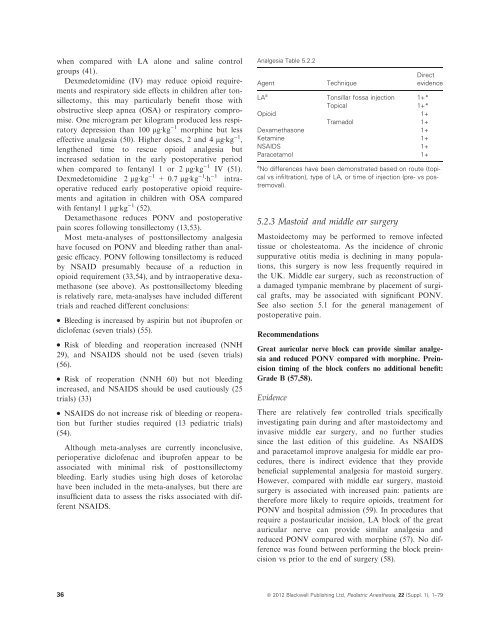Good Practice in Postoperative and Procedural Pain Management ...
Good Practice in Postoperative and Procedural Pain Management ...
Good Practice in Postoperative and Procedural Pain Management ...
You also want an ePaper? Increase the reach of your titles
YUMPU automatically turns print PDFs into web optimized ePapers that Google loves.
when compared with LA alone <strong>and</strong> sal<strong>in</strong>e controlgroups (41).Dexmedetomid<strong>in</strong>e (IV) may reduce opioid requirements<strong>and</strong> respiratory side effects <strong>in</strong> children after tonsillectomy,this may particularly benefit those withobstructive sleep apnea (OSA) or respiratory compromise.One microgram per kilogram produced less respiratorydepression than 100 lgÆkg )1 morph<strong>in</strong>e but lesseffective analgesia (50). Higher doses, 2 <strong>and</strong> 4 lgÆkg )1 ,lengthened time to rescue opioid analgesia but<strong>in</strong>creased sedation <strong>in</strong> the early postoperative periodwhen compared to fentanyl 1 or 2 lgÆkg )1 IV (51).Dexmedetomid<strong>in</strong>e 2 lgÆkg )1 + 0.7 lgÆkg )1 Æh )1 <strong>in</strong>traoperativereduced early postoperative opioid requirements<strong>and</strong> agitation <strong>in</strong> children with OSA comparedwith fentanyl 1 lgÆkg )1 (52).Dexamethasone reduces PONV <strong>and</strong> postoperativepa<strong>in</strong> scores follow<strong>in</strong>g tonsillectomy (13,53).Most meta-analyses of posttonsillectomy analgesiahave focused on PONV <strong>and</strong> bleed<strong>in</strong>g rather than analgesicefficacy. PONV follow<strong>in</strong>g tonsillectomy is reducedby NSAID presumably because of a reduction <strong>in</strong>opioid requirement (33,54), <strong>and</strong> by <strong>in</strong>traoperative dexamethasone(see above). As posttonsillectomy bleed<strong>in</strong>gis relatively rare, meta-analyses have <strong>in</strong>cluded differenttrials <strong>and</strong> reached different conclusions:l Bleed<strong>in</strong>g is <strong>in</strong>creased by aspir<strong>in</strong> but not ibuprofen ordiclofenac (seven trials) (55).l Risk of bleed<strong>in</strong>g <strong>and</strong> reoperation <strong>in</strong>creased (NNH29), <strong>and</strong> NSAIDS should not be used (seven trials)(56).l Risk of reoperation (NNH 60) but not bleed<strong>in</strong>g<strong>in</strong>creased, <strong>and</strong> NSAIDS should be used cautiously (25trials) (33)l NSAIDS do not <strong>in</strong>crease risk of bleed<strong>in</strong>g or reoperationbut further studies required (13 pediatric trials)(54).Although meta-analyses are currently <strong>in</strong>conclusive,perioperative diclofenac <strong>and</strong> ibuprofen appear to beassociated with m<strong>in</strong>imal risk of posttonsillectomybleed<strong>in</strong>g. Early studies us<strong>in</strong>g high doses of ketorolachave been <strong>in</strong>cluded <strong>in</strong> the meta-analyses, but there are<strong>in</strong>sufficient data to assess the risks associated with differentNSAIDS.Analgesia Table 5.2.2AgentTechniqueDirectevidenceLA a Tonsillar fossa <strong>in</strong>jection 1+*Topical 1+*Opioid 1+Tramadol 1+Dexamethasone 1+Ketam<strong>in</strong>e 1+NSAIDS 1+Paracetamol 1+a No differences have been demonstrated based on route (topicalvs <strong>in</strong>filtration), type of LA, or time of <strong>in</strong>jection (pre- vs postremoval).5.2.3 Mastoid <strong>and</strong> middle ear surgeryMastoidectomy may be performed to remove <strong>in</strong>fectedtissue or cholesteatoma. As the <strong>in</strong>cidence of chronicsuppurative otitis media is decl<strong>in</strong><strong>in</strong>g <strong>in</strong> many populations,this surgery is now less frequently required <strong>in</strong>the UK. Middle ear surgery, such as reconstruction ofa damaged tympanic membrane by placement of surgicalgrafts, may be associated with significant PONV.See also section 5.1 for the general management ofpostoperative pa<strong>in</strong>.RecommendationsGreat auricular nerve block can provide similar analgesia<strong>and</strong> reduced PONV compared with morph<strong>in</strong>e. Pre<strong>in</strong>cisiontim<strong>in</strong>g of the block confers no additional benefit:Grade B (57,58).EvidenceThere are relatively few controlled trials specifically<strong>in</strong>vestigat<strong>in</strong>g pa<strong>in</strong> dur<strong>in</strong>g <strong>and</strong> after mastoidectomy <strong>and</strong><strong>in</strong>vasive middle ear surgery, <strong>and</strong> no further studiess<strong>in</strong>ce the last edition of this guidel<strong>in</strong>e. As NSAIDS<strong>and</strong> paracetamol improve analgesia for middle ear procedures,there is <strong>in</strong>direct evidence that they providebeneficial supplemental analgesia for mastoid surgery.However, compared with middle ear surgery, mastoidsurgery is associated with <strong>in</strong>creased pa<strong>in</strong>: patients aretherefore more likely to require opioids, treatment forPONV <strong>and</strong> hospital admission (59). In procedures thatrequire a postauricular <strong>in</strong>cision, LA block of the greatauricular nerve can provide similar analgesia <strong>and</strong>reduced PONV compared with morph<strong>in</strong>e (57). No differencewas found between perform<strong>in</strong>g the block pre<strong>in</strong>cisionvs prior to the end of surgery (58).36 ª 2012 Blackwell Publish<strong>in</strong>g Ltd, Pediatric Anesthesia, 22 (Suppl. 1), 1–79
















